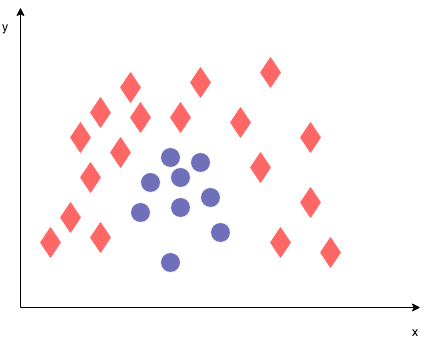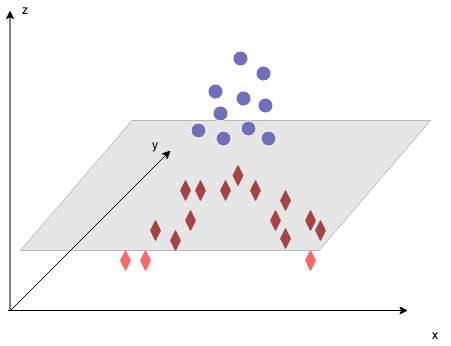In this lesson, you'll learn how to create SVMs for linearly non-separable data using kernels!
You will be able to:
- Understand what the Kernel Trick is and why it is important
- Explain what a Radial Basis Function Kernel is
- Explain what a Sigmoid Kernel is
- Explain what a Polynomial Kernel is
- Apply several non-linear kernel functions in scikit-learn
In the previous lab, we looked at a plot where a linear boundary was clearly not sufficient to separate between the two classes. Another example of where a linear boundary would not work well is shown below. How would you draw a max margin classifier here? We could do it easily by hand, but we cannot draw a straight line. Luckily there is a fairly easy solution, which is denoted by kernelizing your problem such that you can solve non-linear classification problems. Here, we'll introduce kernels.
The idea behind kernel methods to deal with linearly inseparable data is to create (nonlinear) combinations of the original features, and project them on a higher-dimensional space. As shown in the following figure, we can then separate the cases by transforingm a two-dimensional dataset onto a new three-dimensional feature space.
There are several Kernels, and an overview can be found in this lesson, as well as in the scikit-learn documentation here. The idea is that kernels are inner products in a transformed space.
The linear kernel is, as we've seen, the default kernel and simply creates linear decision boundaries. The linear kernel is represented by the inner product of the
There are two parameters when training an SVM with the Radial Basis Function: C and gamma.
-
The parameter C is common to all SVM kernels. Again, by tuning the C parameter when using kernels, you can provide a trafe-off between misclassification of the training set and simplicity of the decision function. a high C will classify as many samples correctly as possible (and might potentially lead to overfitting).
-
Gamma defines how much influence a single training example has. The larger gamma is, the closer other examples must be to be affected.
The RBF kernel is specified as
Gamma has a strong effect on the results: gamma too large will lead to overfitting, a gamma which is too small will lead to underfitting (kind of like a simple linear boundary for a complex problem)
In scikit-learn, you can specify a value for gamma using the attribute gamma. The default gamma value is "auto", if no other gamma is specified, gamma is set to 1/number_of_features (so, 0.5 if 2 classes, 0.333 when 3 classes, etc.). More on parameters in the RBF kernel here.
The Polynomial kernel is specified as
- d can be specified by the keyword
degree. The default degree is 3. - r can be specified by the keyword
coef0. The default is 0.
The sigmoid kernel is specified as:
This kernel is similar to the signoid function in logistic regression.
We explored the differences between SVC, NuSVC and LinearSVC in the previous lab, but let's formalize it once more here:
NuSVC is similar to SVC, but accepts slightly defferent parameters, and the mathematical formulation is also altered slightly.
A new parameter
Just like SVC, NuSVC implements the "one-against-one" approach when there are more than 2 classes. This means that when there are n classes,
LinearSVC is similar to SVC, but instead of the "one-versus-one" method, a "one-vs-rest" method is used. So in this case, when there are n classes, just
You can make predictions using support vector machines. The SVC decision function gives a probability score per class. This is not done by default, however, You'll need to set the probability argument equal to True. Scikit-learn internally performs cross-validations to compute the probabilities, so you can expect that setting probability to True makes the calculations longer. For large data sets, computation times can take considerable proportions.
To get a better understanding of kernels, have a look at this video.
Great! You now know how you can use kernel functions in Support Vector Machines. Let's contrast and compare some of the kernel functions in the next lab!

